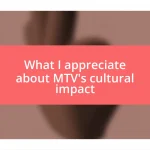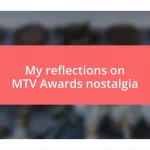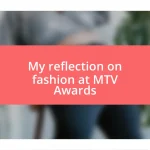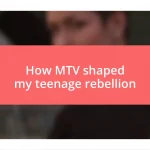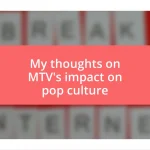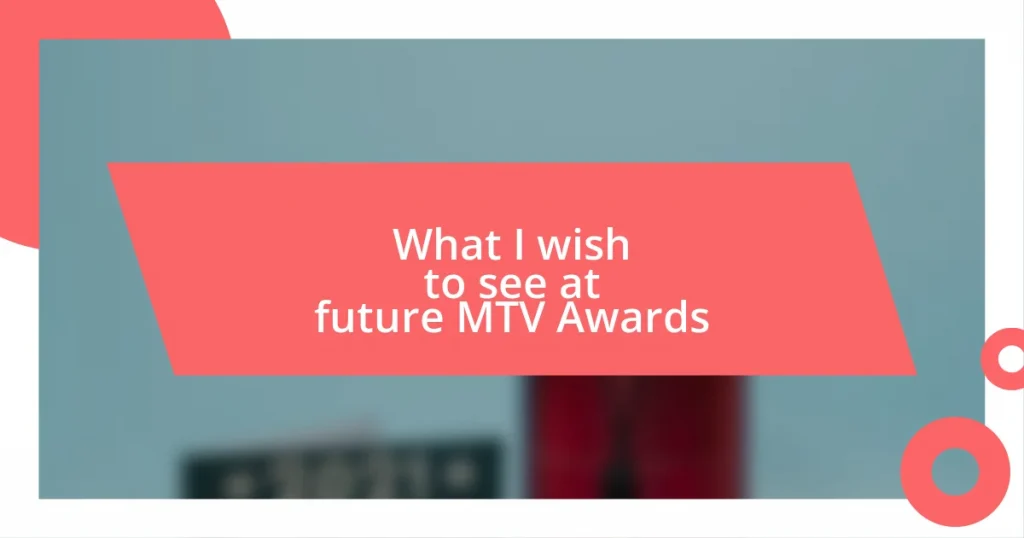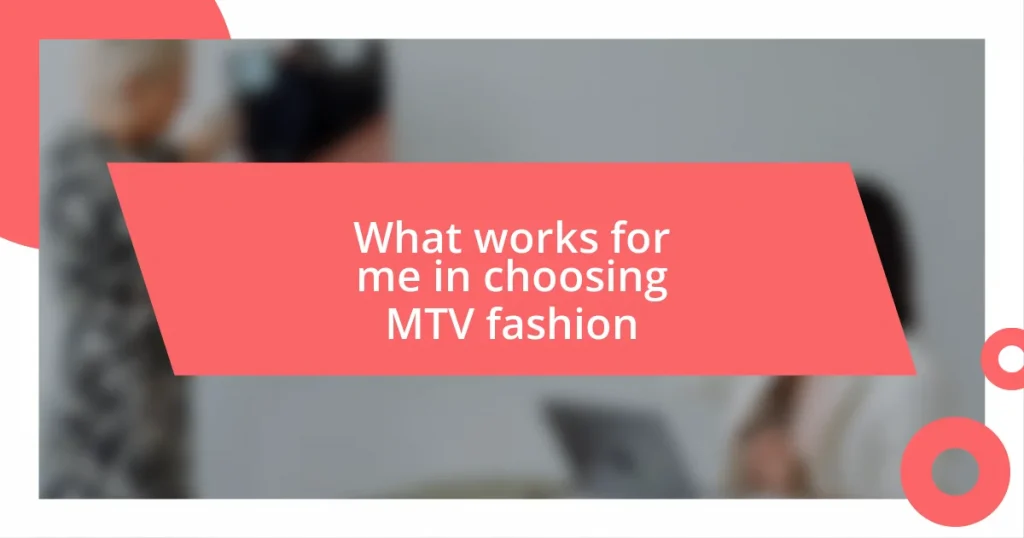Key takeaways:
- The MTV icon era transformed music by combining storytelling with visual artistry, creating cultural moments that united generations.
- Influential artists like Michael Jackson, Madonna, and Prince pushed boundaries, shaped trends, and ignited conversations about identity and societal issues.
- The power of music videos as a medium for self-expression and cultural commentary taught lessons about individuality and societal change.
![]()
Understanding the MTV icon era
The MTV icon era truly transformed the music landscape. I remember being glued to the television, fascinated by the vibrant visuals and larger-than-life personalities that defined this time. It was as if each music video told a story, pulling us into a world of creativity and self-expression—do you remember the specific moments that made your heart race?
As I reflect on this golden age of music television, I feel a wave of nostalgia for the artists who not only shaped the sound but also became cultural icons. For instance, seeing Madonna pushing boundaries in her bold videos inspired a sense of empowerment in a generation that craved authenticity and fearlessness. Wasn’t it incredible how a single video could spark a movement?
The MTV icon era also gave us shared experiences that transcended generations. Watching those iconic award shows, with thrilling performances and unexpected collaborations, felt like a rite of passage for music lovers young and old. How many conversations did you have afterward, dissecting every detail? Those moments connected us, showcasing the power of music to unite and inspire.
![]()
Influential artists of the time
It’s hard to overlook the impact of artists like Michael Jackson during the MTV icon era. I can still remember the first time I saw the “Thriller” video; it was revolutionary. The cinematic quality and groundbreaking choreography were unlike anything I’d ever watched, drawing me in completely. Every time I hear that iconic track, it transports me back to that moment with its electrifying beat and the thrilling visuals.
Then there’s Prince, whose flamboyant persona and eclectic sound left an indelible mark. I felt such a rush watching him perform “Purple Rain” live on stage. His ability to blend genres created music that resonated profoundly with listeners. It wasn’t just about the music; it was the sheer artistry he brought to each performance. He had an uncanny ability to evoke emotion, making every song feel like a personal experience for fans.
Let’s not forget about the raw energy of artists like Guns N’ Roses, who brought a gritty edge to the music scene. Their track “Sweet Child o’ Mine” had me belting out the lyrics at the top of my lungs, feeling every note. The rebellion and passion in their sound ignited a sense of freedom in young audiences. It was electrifying to witness how each artist contributed uniquely to the music culture of that era, creating a tapestry of influences that still resonate today.
| Artist | Key Influence |
|---|---|
| Michael Jackson | Revolutionized music videos with storytelling and choreography |
| Prince | Blended genres and showcased flamboyant artistry |
| Guns N’ Roses | Introduced a gritty edge and a spirit of rebellion |
![]()
Iconic music videos to revisit
Revisiting iconic music videos from the MTV era is like opening a time capsule of creativity. I vividly recall waiting for the world premiere of “Like a Prayer” by Madonna. The powerful imagery, bold themes, and catchy melody made me feel alive, stirring emotions I didn’t even know I had. Each viewing was like an event, leading to countless discussions with friends about its groundbreaking narrative and how it pushed the boundaries of what music videos could represent.
Here’s a short list of standout music videos that still resonate:
- “Thriller” by Michael Jackson: A groundbreaking cinematic experience that revolutionized music videos.
- “Like a Prayer” by Madonna: A provocative blend of themes that challenged societal norms.
- “Sledgehammer” by Peter Gabriel: A masterclass in visual effects that brought art and music together.
- “Vogue” by Madonna: An iconic celebration of dance and fashion that showcased self-expression.
- “Smells Like Teen Spirit” by Nirvana: The raw energy of this video defined a generation’s angst and rebellion.
Each video not only defined an era but also invited us to reflect on our own lives and emotions. I remember feeling a sense of camaraderie whenever one of these songs came on; it was like we were all part of an exclusive club, sharing the thrill of seeing art come to life in such bold ways.
![]()
Cultural impact on society
The cultural impact of MTV during its golden era was profound. I remember vividly how music videos became a primary form of entertainment, shaping not just our tastes but our identities. They provided a visual language that connected diverse groups of people, allowing us to express ourselves in ways that weren’t possible before. Can you recall the feeling when a video would come on, and the world just paused for those few minutes?
MTV also sparked crucial conversations about societal issues, often tackling topics like race, gender, and sexuality. I think back to the first time I saw Madonna’s “Like a Prayer.” It was bold and controversial, pushing the envelope and making many of us question societal norms. The passion it evoked in discussions among peers was electric. It was as if suddenly, we were equipped with a lens to view the world differently—one that recognized the power of art as a catalyst for discussion and change.
Let’s not forget the fashion statements that emerged from this era. Artists like Boy George and Cyndi Lauper weren’t just musicians; they were style icons, influencing how we dressed and expressed ourselves. I can still picture the bright colors and daring styles I tried to emulate. Watching them on screen inspired so many of us to embrace our individuality boldly—didn’t you feel that urge to express yourself through fashion? The music and visuals blended seamlessly, creating a cultural phenomenon that shaped both our personal and collective identities.
![]()
How MTV shaped music trends
MTV revolutionized how we experienced music, turning it into a visual spectacle. I remember the anticipation of watching the latest music video, feeling like I was part of something much bigger. The network didn’t just promote songs; it created cultural moments that we lived and breathed. In those days, if you missed a premiere, it felt like you’d missed a piece of history, didn’t it?
The influence of MTV extended beyond music; it dictated trends in style and aesthetics. I vividly recall mimicking the dramatic eyeliner and bold outfits of my favorite artists. Seeing artists like Madonna and Duran Duran on screen inspired a sense of freedom to experiment with my own look. It wasn’t just a music video—each clip was a mini runway show, a showcase of what was cool and daring. I often wonder how many of us tried to capture that same magic in our daily lives, using fashion as our own form of self-expression.
MTV also highlighted emerging genres and marginalized voices, gifting us a diverse soundscape. I still remember the first time I saw “Walk This Way” by Run-D.M.C. featuring Aerosmith. It was groundbreaking to see hip-hop fuse with rock, and it opened up a world of collaboration that I never thought possible. This blending of genres encouraged many of us to explore music beyond our comfort zones. Didn’t it feel like every video was an invitation to discover something new? MTV not only shaped the music we loved but transformed our musical identities forever.
![]()
Personal memories and reflections
I can still remember gathering with friends after school to watch MTV—those afternoons felt magical. We’d plop down in front of the TV, snacks in hand, and eagerly wait for our favorite videos to play. Each tune brought a rush of excitement, and it felt like those moments created unbreakable bonds between us. How could something so simple feel so monumental?
One of my strongest memories is the day the “Thriller” video premiered. I was mesmerized by the storytelling, the choreography, and the whole vibe. Watching Michael Jackson transform into a creature of the night felt thrilling and a bit scary at the same time. I remember trying to imitate those iconic dance moves in my living room, laughing at how clumsy I was, yet feeling like a star in my own right. Did anyone else experience that enchanting mix of fear and joy as we danced along?
There were also those late-night viewing parties where we’d debate which videos deserved to win the coveted “Best Video” awards. I can still hear the spirited arguments—who could forget the artistry of Peter Gabriel’s “Sledgehammer”? Those discussions opened my eyes to the nuances of creativity and sparked an appreciation for different art forms. Each video wasn’t just a song; it was a work of art that invited us to think, feel, and interpret in our own way. How amazing was it to be part of a generation that navigated these energetic discussions together?
![]()
Lessons learned from the era
Reflecting on the MTV era, I’ve learned that the power of visual storytelling in music can’t be underestimated. The clips were like mini-movies, conveying emotions and narratives that expanded my understanding of the songs. I can still feel the adrenaline rush when I first saw Guns N’ Roses’ “November Rain.” It was a cinematic experience, and it made me realize that music videos could evoke feelings just like films do. Have you ever had a song that just transported you back to a moment in your life?
One of the vital lessons from this era was the celebration of individuality. Artists like Cyndi Lauper and Boy George broke the mold, teaching us the importance of self-expression. I remember being drawn to their vibrant and unapologetic styles, which encouraged me to embrace my uniqueness. It struck me that the more authentic we are, the more connection we create with others. Does that resonate with anyone else?
Moreover, MTV taught me about the cultural shifts happening around us. From the emergence of hip-hop to the rise of alternative rock, music videos provided a lens into societal changes. Each video told a story of its time, revealing the complexities of identity, race, and social justice. I recall being inspired by the raw energy of Nirvana’s “Smells Like Teen Spirit”—it was a wake-up call that spoke to the voice of a generation. How empowering it was to witness artists use their platform to challenge the status quo!



